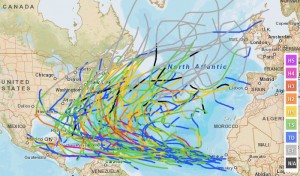29 April 2015
Lucky break kept major hurricanes offshore since 2005
Posted by Nanci Bompey
By Larry O’Hanlon

A map showing all of the North Atlantic storm tracks from 2006 to 2013, color coded by intensity. A new study finds that the U.S. experienced a hurricane “drought” over the last nine years, with no storms of category 3 or higher making landfall.
Credit NOAA
For the last nine years the United States has dodged the hurricane bullet: No major tropical cyclones have made U.S. landfall. Such a remarkable “hurricane drought” has never been seen before – since records began in 1851. It beats the previous record of eight years from 1861-1868, say researchers who have looked into the probabilities of the unusual streak, what it means for the chances of hurricanes this year and whether or not insurance premiums reflect the risks. Their conclusion: the hurricane drought is mostly a matter of dumb luck.
The last major hurricane – of Category 3 or higher – to make landfall in the U.S. was Hurricane Wilma in 2005. There have been other damaging storms – Ike (Category 2, 2008), Irene (Category 1, 2011), Sandy (Category 1, 2012), and several category 3 or higher storms have hit Cuba in the past nine years. But the U.S. has managed to avoid the peak power of these storms, with one result being that many people don’t feel high premiums are justified for insurance against wind damage – which is the highest cost damage done by major hurricanes.
“There’s been a lot of talk about how unusual the string is, and we want to quantify it,” said hurricane researcher Timothy Hall of the NASA Goddard Institute for Space Studies in New York City, and lead author of the new study in Geophysical Research Letters, a journal of the American Geophysical Union.
To figure the odds of such a long ‘drought,’ Hall and Kelly Hereid, who works for ACE Tempest Reinsurance in Stamford, Conn., used a computer model that takes into account the major factors known to enable or suppress hurricanes – like storm-fueling high sea surface temperatures in the Atlantic and hurricane-suppressing El Niño conditions in the Pacific.
The researchers simulated the years 1950 through 2012 a thousand times to learn how often under that known range of conditions virtual hurricanes managed to cross into 19 U.S. states ranging from Texas to Maine. That gave Hall and Hereid enough data to begin to say something about the odds of major storms making landfall in the U.S. and the chances of hurricane droughts.
Typically, about a quarter of all tropical cyclones in the North Atlantic make landfall in the U.S., said Hall. Their analysis shows that the mean wait time before a nine-year hurricane drought occurred is 177 years. That suggests the current situation is rare, but far from impossible. They also found that the average annual odds of at least one U.S. landfall is 0.39, or a little greater than one-in-three. Those odds have no more connection to how many hurricane-free years came before the landfall than the outcome of a coin toss does to preceding tosses coming up heads or tails. “The current year forgets the year before,” said Hall.
The results suggest that there is nothing unusual underlying the current hurricane drought. There’s no extraordinary lack of hurricane activity, for example.
“When we looked qualitatively at the nine-year drought, they aren’t inactive seasons,” said Hall. There has been no significant change in the number of North Atlantic tropical cyclones, the amounts of energy powering them, nor any other hurricane metric. “I don’t believe there is a major regime shift that’s protecting the U.S.”
On the other hand, now, just a few months in advance of the 2015 season, there are some known factors that could extend the hurricane drought another year. El Niño has finally taken hold in the Pacific, which tends to lead to strong winds over the Atlantic that make it hard for hurricanes to form. If so, that weighs the dice in favor of another year without a major hurricane landfall in the U.S., and that could affect insurance rates.
“My co-author is from the reinsurance industry,” said Hall, referring to the firms that essentially insure the insurance companies. “It’s their clients who have to pay the premiums.” And because reinsurers don’t want to lose market share to smaller, temporary boutique insurers who pop up and offer lower rates, they’re pressured to drop their rates to compete.
“Many (boutique insurers) don’t last more than a few years, but they drive the rates down,” said Hall. “But if at some point (premiums) become decoupled from actual risk, it is a problem.”
– Freelance science journalist Larry O’Hanlon acts as AGU’s blogs manager and social media coordinator.










 GeoSpace is a blog on Earth and space science, managed by AGU’s Public Information staff. The blog features posts by AGU writers and guest contributors on all sorts of relevant science topics, but with a focus on new research and geo and space sciences-related stories that are currently in the news.
GeoSpace is a blog on Earth and space science, managed by AGU’s Public Information staff. The blog features posts by AGU writers and guest contributors on all sorts of relevant science topics, but with a focus on new research and geo and space sciences-related stories that are currently in the news.